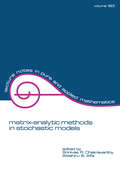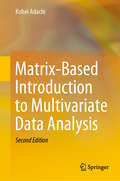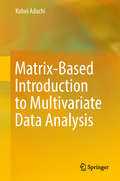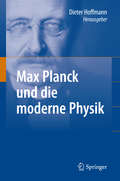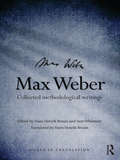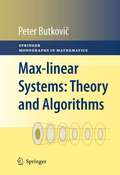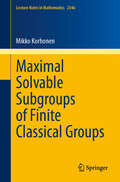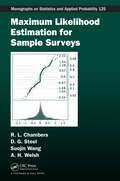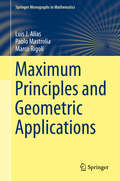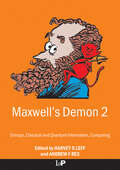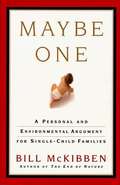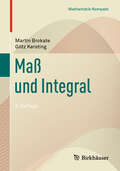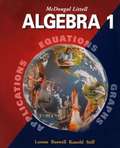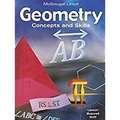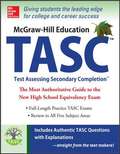- Table View
- List View
Matrix-Analytic Methods in Stochastic Models (Lecture Notes in Pure and Applied Mathematics)
by Attahiru S. Alfa Srinivas R. ChakravarthyBased on the proceedings of the first International Conference on Matrix-Analytic Methods (MAM) in Stochastic Models, held in Flint, Michigan, this book presents a general working knowledge of MAM through tutorial articles and application papers. It furnishes information on MAM studies carried out in the former Soviet Union.
Matrix-Based Introduction to Multivariate Data Analysis
by Kohei AdachiThis is the first textbook that allows readers who may be unfamiliar with matrices to understand a variety of multivariate analysis procedures in matrix forms. By explaining which models underlie particular procedures and what objective function is optimized to fit the model to the data, it enables readers to rapidly comprehend multivariate data analysis. Arranged so that readers can intuitively grasp the purposes for which multivariate analysis procedures are used, the book also offers clear explanations of those purposes, with numerical examples preceding the mathematical descriptions.Supporting the modern matrix formulations by highlighting singular value decomposition among theorems in matrix algebra, this book is useful for undergraduate students who have already learned introductory statistics, as well as for graduate students and researchers who are not familiar with matrix-intensive formulations of multivariate data analysis.The book begins by explaining fundamental matrix operations and the matrix expressions of elementary statistics. Then, it offers an introduction to popular multivariate procedures, with each chapter featuring increasing advanced levels of matrix algebra. Further the book includes in six chapters on advanced procedures, covering advanced matrix operations and recently proposed multivariate procedures, such as sparse estimation, together with a clear explication of the differences between principal components and factor analyses solutions. In a nutshell, this book allows readers to gain an understanding of the latest developments in multivariate data science.
Matrix-Based Introduction to Multivariate Data Analysis
by Kohei AdachiThis book enables readers who may not be familiar with matrices to understand a variety of multivariate analysis procedures in matrix forms. Another feature of the book is that it emphasizes what model underlies a procedure and what objective function is optimized for fitting the model to data. The author believes that the matrix-based learning of such models and objective functions is the fastest way to comprehend multivariate data analysis. The text is arranged so that readers can intuitively capture the purposes for which multivariate analysis procedures are utilized: plain explanations of the purposes with numerical examples precede mathematical descriptions in almost every chapter. This volume is appropriate for undergraduate students who already have studied introductory statistics. Graduate students and researchers who are not familiar with matrix-intensive formulations of multivariate data analysis will also find the book useful, as it is based on modern matrix formulations with a special emphasis on singular value decomposition among theorems in matrix algebra. The book begins with an explanation of fundamental matrix operations and the matrix expressions of elementary statistics, followed by the introduction of popular multivariate procedures with advancing levels of matrix algebra chapter by chapter. This organization of the book allows readers without knowledge of matrices to deepen their understanding of multivariate data analysis.
Matroids: A Geometric Introduction
by Gary Gordon Jennifer McnultyMatroid theory is a vibrant area of research that provides a unified way to understand graph theory, linear algebra and combinatorics via finite geometry. This book provides the first comprehensive introduction to the field which will appeal to undergraduate students and to any mathematician interested in the geometric approach to matroids. Written in a friendly, fun-to-read style and developed from the authors' own undergraduate courses, the book is ideal for students. Beginning with a basic introduction to matroids, the book quickly familiarizes the reader with the breadth of the subject, and specific examples are used to illustrate the theory and to help students see matroids as more than just generalizations of graphs. Over 300 exercises are included, with many hints and solutions so students can test their understanding of the materials covered. The authors have also included several projects and open-ended research problems for independent study.
Mauritius Mathematics Grade 7 (Part-I) - MIE
by Mauritius Institute of EducationMauritius Mathematics Grade 7 (Part-I) Textbook Mauritius Institute of Education.
Mauritius Mathematics Grade 7 (Part-II) - MIE
by Mauritius Institute of EducationThe Mathematics Grade 7 textbook by Mauritius Institute of Education.
Max Planck und die moderne Physik
by Dieter HoffmannMax Planck (1858-1947) zählt zu den herausragenden Physikern des zwanzigsten Jahrhunderts. Seine Quantenhypothese wurde zur Grundlage für die Entwicklung der Quantentheorie und bildet eine der zentralen Säulen der modernen Physik. Damit ist Plancks Wirken jedoch keineswegs erschöpfend charakterisiert: In diesem Buch arbeiten anerkannte Physikhistoriker das gesamte Spektrum von Plancks physikalischem Schaffen heraus und würdigen seine Bedeutung für die Entwicklung der modernen Physik.
Max Weber: Collected Methodological Writings (Weber in Translation)
by Sam Whimster Hans Henrik BruunWeber’s methodological writings form the bedrock of key ideas across the social sciences. His discussion of value freedom and value commitment, causality, understanding and explanation, theory building and ideal types have been of fundamental importance, and their impact remains undiminished today. These ideas influence the current research practice of sociologists, historians, economists and political scientists and are central to debates in the philosophy of social science. But, until now, Weber's extensive writings on methodology have lacked a comprehensive publication. Edited by two of the world's leading Weber scholars, Collected Methodological Writings will provide a completely new, accurate and reliable translation of Weber’s extensive output, including previously untranslated letters. Accompanying editorial commentary explains the context of, and interconnections between, all these writings, and additional useful features include a glossary of German terms and an English key, endnotes, bibliography, and person and subject indexes.
Max-linear Systems: Theory and Algorithms
by Peter ButkovičRecent years have seen a significant rise of interest in max-linear theory and techniques. Specialised international conferences and seminars or special sessions devoted to max-algebra have been organised. This book aims to provide a first detailed and self-contained account of linear-algebraic aspects of max-algebra for general (that is both irreducible and reducible) matrices. Among the main features of the book is the presentation of the fundamental max-algebraic theory (Chapters 1-4), often scattered in research articles, reports and theses, in one place in a comprehensive and unified form. This presentation is made with all proofs and in full generality (that is for both irreducible and reducible matrices). Another feature is the presence of advanced material (Chapters 5-10), most of which has not appeared in a book before and in many cases has not been published at all. Intended for a wide-ranging readership, this book will be useful for anyone with basic mathematical knowledge (including undergraduate students) who wish to learn fundamental max-algebraic ideas and techniques. It will also be useful for researchers working in tropical geometry or idempotent analysis.
Maximal Solvable Subgroups of Finite Classical Groups (Lecture Notes in Mathematics #2346)
by Mikko KorhonenThis book studies maximal solvable subgroups of classical groups over finite fields. It provides the first modern account of Camille Jordan's classical results, and extends them, giving a classification of maximal irreducible solvable subgroups of general linear groups, symplectic groups, and orthogonal groups over arbitrary finite fields. A subgroup of a group G is said to be maximal solvable if it is maximal among the solvable subgroups of G. The history of this notion goes back to Jordan’s Traité (1870), in which he provided a classification of maximal solvable subgroups of symmetric groups. The main difficulty is in the primitive case, which leads to the problem of classifying maximal irreducible solvable subgroups of general linear groups over a field of prime order. One purpose of this monograph is expository: to give a proof of Jordan’s classification in modern terms. More generally, the aim is to generalize these results to classical groups over arbitrary finite fields, and to provide other results of interest related to irreducible solvable matrix groups. The text will be accessible to graduate students and researchers interested in primitive permutation groups, irreducible matrix groups, and related topics in group theory and representation theory. The detailed introduction will appeal to those interested in the historical background of Jordan’s work.
Maximum Likelihood Estimation and Inference
by Russell B. MillarThis book takes a fresh look at the popular and well-established method of maximum likelihood for statistical estimation and inference. It begins with an intuitive introduction to the concepts and background of likelihood, and moves through to the latest developments in maximum likelihood methodology, including general latent variable models and new material for the practical implementation of integrated likelihood using the free ADMB software. Fundamental issues of statistical inference are also examined, with a presentation of some of the philosophical debates underlying the choice of statistical paradigm.Key features:Provides an accessible introduction to pragmatic maximum likelihood modelling.Covers more advanced topics, including general forms of latent variable models (including non-linear and non-normal mixed-effects and state-space models) and the use of maximum likelihood variants, such as estimating equations, conditional likelihood, restricted likelihood and integrated likelihood.Adopts a practical approach, with a focus on providing the relevant tools required by researchers and practitioners who collect and analyze real data.Presents numerous examples and case studies across a wide range of applications including medicine, biology and ecology.Features applications from a range of disciplines, with implementation in R, SAS and/or ADMB.Provides all program code and software extensions on a supporting website.Confines supporting theory to the final chapters to maintain a readable and pragmatic focus of the preceding chapters. This book is not just an accessible and practical text about maximum likelihood, it is a comprehensive guide to modern maximum likelihood estimation and inference. It will be of interest to readers of all levels, from novice to expert. It will be of great benefit to researchers, and to students of statistics from senior undergraduate to graduate level. For use as a course text, exercises are provided at the end of each chapter.
Maximum Likelihood Estimation for Sample Surveys (Chapman & Hall/CRC Monographs on Statistics and Applied Probability)
by Raymond L. Chambers David G. Steel Suojin Wang Alan WelshSample surveys provide data used by researchers in a large range of disciplines to analyze important relationships using well-established and widely used likelihood methods. The methods used to select samples often result in the sample differing in important ways from the target population and standard application of likelihood methods can lead to
Maximum Principles and Geometric Applications
by Luis J. Alías Paolo Mastrolia Marco RigoliThis monograph presents an introduction to some geometric and analytic aspects of the maximum principle. In doing so, it analyses with great detail the mathematical tools and geometric foundations needed to develop the various new forms that are presented in the first chapters of the book. In particular, a generalization of the Omori-Yau maximum principle to a wide class of differential operators is given, as well as a corresponding weak maximum principle and its equivalent open form and parabolicity as a special stronger formulation of the latter. In the second part, the attention focuses on a wide range of applications, mainly to geometric problems, but also on some analytic (especially PDEs) questions including: the geometry of submanifolds, hypersurfaces in Riemannian and Lorentzian targets, Ricci solitons, Liouville theorems, uniqueness of solutions of Lichnerowicz-type PDEs and so on. Maximum Principles and Geometric Applications is written in an easy style making it accessible to beginners. The reader is guided with a detailed presentation of some topics of Riemannian geometry that are usually not covered in textbooks. Furthermore, many of the results and even proofs of known results are new and lead to the frontiers of a contemporary and active field of research.
Maxwell's Demon 2 Entropy, Classical and Quantum Information, Computing
by Harvey S Leff Andrew F RexOver 130 years ago, James Clerk Maxwell introduced his hypothetical "demon" as a challenge to the scope of the second law of thermodynamics. Fascination with the demon persisted throughout the development of statistical and quantum physics, information theory, and computer science, and links have been established between Maxwell's demon and each of
May Contain Lies: How Stories, Statistics, and Studies Exploit Our Biases—And What We Can Do about It
by Alex EdmansHow our biases cause us to fall for misinformation—and how to combat it. Our lives are minefields of misinformation. It ripples through our social media feeds, our daily headlines, and the pronouncements of politicians, executives, and authors. Stories, statistics, and studies are everywhere, allowing people to find evidence to support whatever position they want. Many of these sources are flawed, yet by playing on our emotions and preying on our biases, they can gain widespread acceptance, warp our views, and distort our decisions. In this eye-opening book, renowned economist Alex Edmans teaches us how to separate fact from fiction. Using colorful examples—from a wellness guru’s tragic but fabricated backstory to the blunders that led to the Deepwater Horizon disaster to the diet that ensnared millions yet hastened its founder’s death—Edmans highlights the biases that cause us to mistake statements for facts, facts for data, data for evidence, and evidence for proof. Armed with the knowledge of what to guard against, he then provides a practical guide to combat this tide of misinformation. Going beyond simply checking the facts and explaining individual statistics, Edmans explores the relationships between statistics—the science of cause and effect—ultimately training us to think smarter, sharper, and more critically. May Contain Lies is an essential read for anyone who wants to make better sense of the world and better decisions.
Maybe One: A Personal and Environmental Argument for Single-Child Families
by Bill MckibbenFrom the ground breaking author of "The End of Nature" comes a provocative, compelling, and environmentally sound argument for saving the planet through voluntary population control.
Maß und Integral (Mathematik Kompakt)
by Martin Brokate Götz KerstingDer Integralbegriff in seiner Ausprägung durch Henri Lebesgue ist ein grundlegendes Werkzeug in der modernen Analysis, Numerik und Stochastik. Für Lehrveranstaltungen zu diesen Gebieten der Mathematik bereiten die Autoren wesentliche Sachverhalte in kompakter Weise auf. Das Buch liefert Orientierung und Material für verschiedene Varianten zwei- oder vierstündiger Lehrveranstaltungen. In einem ergänzenden Abschnitt werden um den Begriff der Konvexität herum Verbünde zur Funktionalanalysis hergestellt.
Maß- und Integrationstheorie: Mit zahlreichen Beispielen und Übungsaufgaben
by Uwe Storch Hartmut Wiebe Claas BeckerIn diesem Lehrbuch wird die klassische Lebesguesche Maß- und Integrationstheorie stringent entwickelt und dargestellt – trotz großem Tiefgang ist das Buch dadurch gut lesbar. Die einzelnen Abschnitte werden außerdem durch zahlreiche Beispiele und Aufgaben illustriert und ergänzt. Das Buch ist somit sowohl zum Selbststudium als auch als Nachschlagewerk sehr gut geeignet. Grundkenntnisse aus Mengenlehre und Analysis sowie gelegentlich auch Linearer Algebra und Topologie werden vorausgesetzt. Bei Bedarf können diese in den beiden Büchern Grundkonzepte der Mathematik und Analysis einer Veränderlichen der Autoren U. Storch und H. Wiebe nachgelesen werden.
McDougal Littell Geometry: Concepts and Skills
by Ron Larson Laurie Boswell Lee StiffTextbook on geometry.
McDougal Littell Math (Course 1 #2)
by Ron Larson Laurie Boswell Lee Stiff Timothy D. KanoldThe book covers a vast range of topics like rational numbers, operations,equations and functions, geometry, square roots, and probability and provides instruction and practice on standardized test questions in many formats.
McDougal Littell Middle School Math: Course 2
by Ron Larson Laurie BoswellMiddle school math textbook
McGraw-Hill Education TASC - Test Accessing Secondary Completion
by Kathy A. ZahlerIt's packed with everything you need to succeed on the test---and get the high school credential you want. Only this guide can show you exactly what to expect on the test, tell you how the test is scored, and give you authentic TASC questions for practice. That makes this bestselling guide your most reliable and accurate source for everything you need to know about the TASC.
